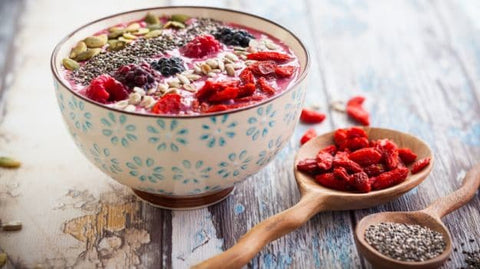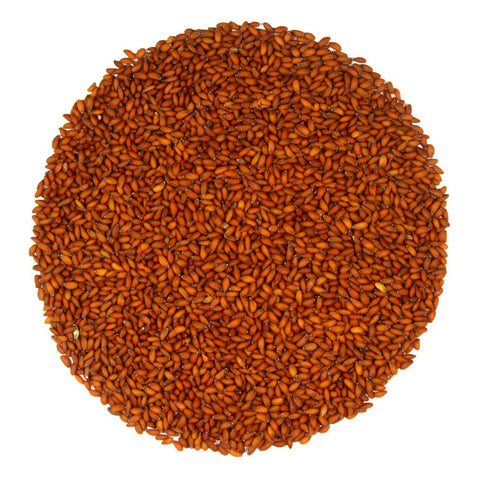chickpeas
Healthy Fiber. People often praise chickpeas (also known as garbanzo beans) for their high protein content of 15 grams per cooked cup. But in many ways, it’s their impressive amount of fiber – 12 grams per cooked cup, or nearly half of the recommended daily value (DV) for women and nearly one-third of the recommended DV for men) – that is linked to most of its health benefits. Because most of this fiber is in the insoluble form, studies have shown chickpeas help lower the more harmful form of LDL cholesterol, reduce risk of heart disease and help balance blood sugar level. A broad set of vitamins and minerals, including calcium, vitamin K, magnesium and zinc, also means chickpeas help promote strong bones.
More Uses for Chickpeas
Chickpeas make a hearty addition to pilafs, grain dishes and salads. Puréeing them creates a base for dips like hummus, and adding chickpea flour to baked goods adds fiber and protein (plus, it’s gluten-free). If you’re using canned chickpeas or soaking dry ones, don’t waste the liquid: Also known as aquafaba, the liquid can mimic proteins in egg whites and can be used similarly to create a whipped effect in baked treats like meringue.
Protein Power. Don’t let their small size fool you – hemp hearts (also known as shelled hemp seeds) are nutritional heavyweights. A North American crop, hemp hearts are a fine source of plant-based protein (5 grams per 2-tablespoon serving). They are also composed of 30% healthy fat, which is largely made up of essential fatty acids (EFAs) in the optimal ratio for human health, including gamma-linolenic-acid (GLA), an omega-6 fat used to fight inflammatory conditions. Hemp contains pH-balancing chlorophyll (yes, the same chlorophyll that gives leafy greens their pigment). Add in an impressive supply of minerals (like iron) plus a dose of fiber, and it’s easy to see why hemp is revered.
More Uses for Hemp Seeds
With a soft texture and nutty taste, hemp seeds can be used in sweet and savory dishes. Try them folded into pasta, mixed into pancake batter or sprinkled on a smoothie bowl. They become creamy when blended, making them great for smoothies, salad dressings and sauces.
Immunizing Powerhouse. Japanese mushrooms like shiitake and maitake (also called “hen of the woods”) earn their title of “medicinal mushrooms,” offering powerful support in boosting the immune system and increasing life-span. Recent studies have linked their effectiveness to controlling blood sugar, protecting the liver and helping fight autoimmune diseases and some forms of cancer (including breast and gastric cancer). Low in calories and rich in B vitamins, iron and many other micro nutrients, these fungi offer a wealth of advantages.
More Uses for Japanese Mushrooms
Meaty and rich in umami flavor, both shiitake and maitake are delectable additions to stir-fries, soups, sandwiches and virtually any kind of savory recipe. A quick sauté in a hot pan is all they need to enhance their flavor and succulent texture while still retaining beneficial nutrients. Dried versions of these mushrooms are also available; they need to be rehydrated by soaking in hot water and can then be used in the same way. A trick to add deep flavor to your dishes: Soak your dried mushrooms in hot water, then use the soaking liquid as a broth, and chop and use the mushrooms in your cooking for a double dose of umami flavor.
Mushroom Cashew Lettuce Wraps Recipe
Gut Support. Think of kefir as a supercharged version of yogurt, offering a similar flavor and function but significantly enhanced with an increased variety and quantity of gut-friendly probiotics. These “friendly” bacteria can help with everything from enhancing absorption of nutrients from the food you eat and easing digestive problems to bolstering the immune system and preventing disease – and they act as an antibacterial (the good bacteria help fight and crowd out the bad). For those who are avoiding dairy, fear not: Non-dairy varieties of kefir made with superfoods like coconut are available as well. (For more on the power of probiotics, check out "Expert Advice to Fix Your Gut Right Now")
More Uses for Kefir
Aside from being a stand- alone beverage, kefir can also be added to various types of recipes such as smoothies and breakfast bowls. Try it as a substitute for cream in chilled soups, or blend kefir with fruit to make ice pops. Remember that high heat can destroy probiotics, so always aim to use kefir in uncooked contexts.
Lemon & Herb Kefir Spread Recipe
Apple, Frisée & Radicchio Salad with Lemon Kefir Dressing Recipe
Anticancer Agent. All leafy greens are good for you, but watercress stands out as one of the best. Multiple studies have shown watercress’s effects in reducing DNA damage and against cancer, showing particular promise in cases of lung and oral cancers. Thanks to a high content of lutein and beta-carotene, regular watercress consumption has also been linked to lower incidence of eye disorders, including cataracts and age-related macular degeneration. Watercress is rich in chlorophyll and antioxidants and contains over 15 vitamins and minerals, such as vitamin C, iron and calcium.
More Uses for Watercress
For maximum health benefits, raw or very lightly cooked watercress should be consumed regularly. Its crisp and peppery flavor is a refreshing addition to salads or pilafs, stirred into cooked pasta or sprinkled on top of pizza.
Green Energy. In terms of nutrient-dense foods, spirulina is at the top of the list. Often referred to as nature’s multivitamin, spirulina’s micronutrient content is nothing short of astounding: gram for gram, it contains 180% more calcium than whole milk, 5,100% more iron than spinach and 3,100% more beta-carotene than carrots – in fact, just 3 grams of spirulina exhibits more antioxidant and anti-inflammatory activities than five servings of fruits and vegetables! There are over 200 scientific studies and clinical trials that showcase the benefits of spirulina, which include enhancing the immune system and treating and preventing allergies, oral cancer and other types of cancers, liver disorders and inflammatory diseases such as heart disease. Spirulina nourishes the body throughout and acts as a natural energizer.
More Uses for Spirulina
While spirulina should not be cooked (heat destroys its valuable properties), it makes a wonderful addition to smoothies, drinks, sauces and dressings. Try mixing the powder into foods that are green, such as guacamole or pesto – just remember, a little goes a long way.
Amaranth Falafels with Green Tahini Sauce Recipe
Beauty Boost This “rainforest blueberry,” hailing from the Patagonian region of Chile, is noticeably rich in purple pigment – an indication of its exceptionally high concentration of anthocyanin antioxidants, making maqui one of the most antioxidant-rich foods in nature. These anthocyanins are behind the growing interest in maqui among the medical community, particularly with regard to the berry’s link to enhanced respiratory and cardiovascular health. Combined with its wealth of vitamin C, maqui is an extremely effective tool for skin rejuvenation, collagen production and overall healthy, graceful aging.
More Uses for Maqui Berry
In North America, maqui is most often found in powdered form, and it can be used in all types of uncooked applications, from smoothies to sauces to frozen desserts. Though its deep purple hue is instantly recognizable, maqui has very little flavor, allowing it to swing easily between both sweet and savory uses.
Black Bean Tacos with Maqui Berry Salsa Recipe
Minerally Charged. A brown seaweed, wakame contains a wealth of naturally occurring electrolytes such as calcium and magnesium, and other minerals such as manganese and iron. Wakame is also a very rich source of iodine, a mineral that’s essential for a healthy thyroid gland, which produces hormones that regulate many important functions including metabolism. In addition, it boasts anticancer, antibacterial, antiviral and antiparasitic properties. These qualities are largely due to its high concentration of fucoidan, a polysaccharide that fights inflammation, infection, high blood pressure and allergies.
More Uses for Wakame
Wakame can be cooked into soups, stews and bean dishes, where it imparts a slightly salty flavor. It can also be briefly soaked to soften, then chopped and added to grain and rice dishes. You can grind it and mix with salt, pepper and dried herbs to make an all-purpose table seasoning.
Wakame Avocado Purée Recipe
Prebiotic Sweetener. A sweetener that’s actually good for your gut may sound like an oxymoron, but yacon is a very special tuber – although it tastes sweet and can be extracted into a luxurious syrup, its impact on blood glucose is minimal. This amazing quality is mostly due to low-calorie yacon’s impressive concentration of fructooligosaccharides (FOS), which are indigestible carbohydrates that pass through the body unabsorbed. Not only is it beneficial for diabetic diets as well as for weight loss, FOS is also considered a prebiotic, helping to promote the growth of probiotics, thereby improving gut health. In addition to a syrup, yacon can also be purchased as whole dehydrated slices, which have the benefit of offering additional fiber. Fresh yacon root can be found in specialty grocery stores.
More Uses for Yacon
Yacon syrup can be used similarly to maple syrup or honey. Drizzle it on top of pancakes or porridge, use it to adorn desserts or mix a little into sauces and marinades that need a sweet touch, like a barbecue glaze.
Salted Chocolate Almond Butter Cups Recipe
Selenium King. Eating a handful of nuts a day has been shown to enhance longevity, and Brazil nuts are no exception. Rich in healthy fat and fiber, these large nuts help lower cholesterol, promote heart heath and are a good source of minerals like magnesium and calcium. The Brazil nut’s biggest claim to fame, though, is one mineral in particular: selenium. Selenium has antioxidant properties, is necessary for the production of thyroid hormones and may also help to reduce the risk of breast cancer. Brazil nuts are so rich in selenium that eating just one a day will meet your requirements.
More Uses for Brazil Nuts
Brazil nuts are a delicious snack alone or as part of a trail mix. They can be chopped and used as a crunchy topping for grain bowls and salads, cooked into stews, or ground and added to veggie patties or burgers. Additionally, these nuts can also be blended with water then strained to make a dreamy milk that can be used for any milk or cream application.












